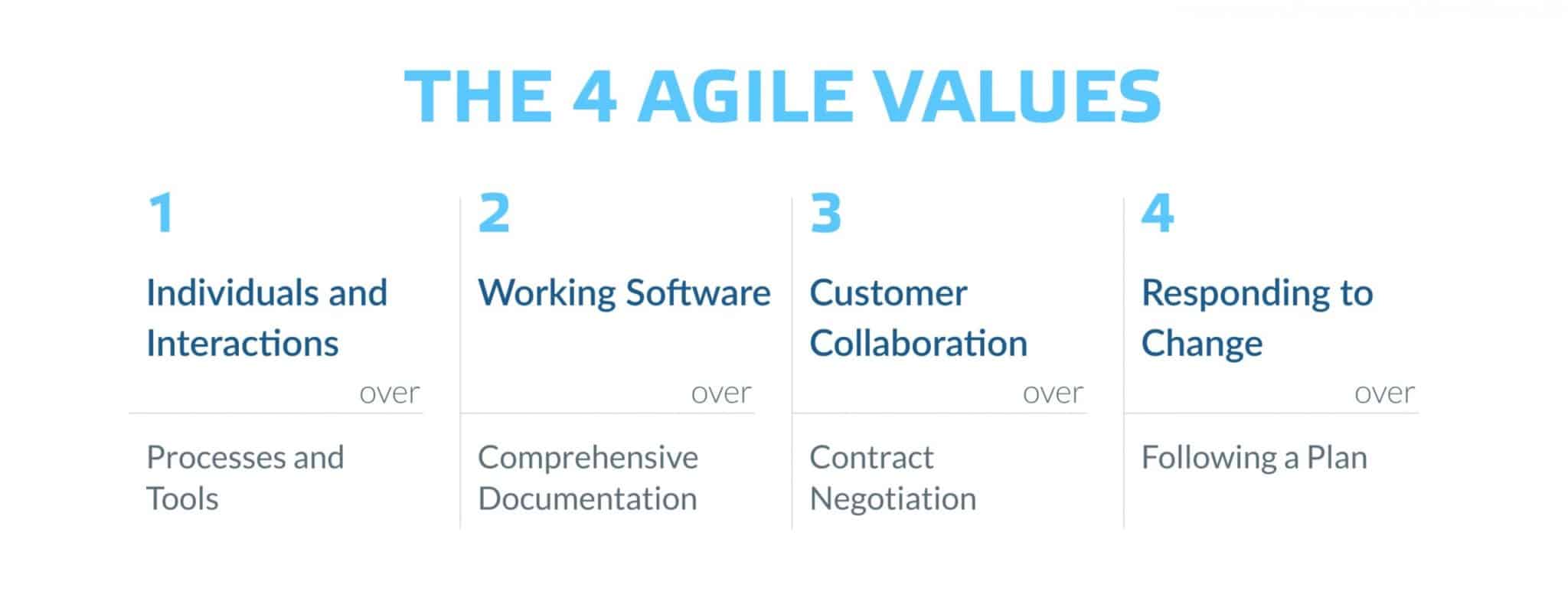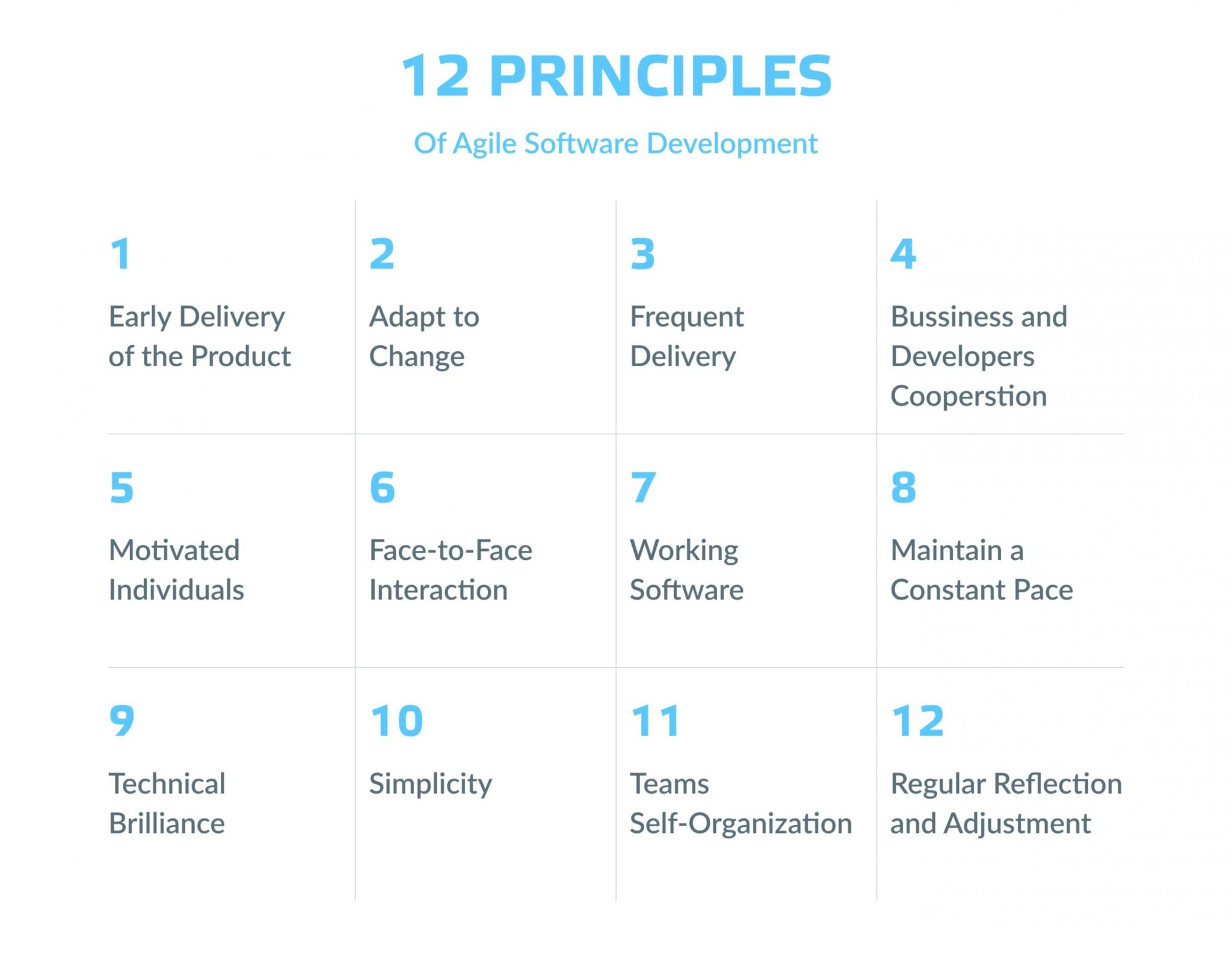What is agile project management?
Agile is a software development and project management approach based on iterations and fast product delivery to clients. In the other words, the team works iteratively giving ongoing results and value, which are being assessed continuously. This process resembles an accurate mechanism, where pieces work together to carry out one common goal but, also, flexibly respond to the changes.
As Agile is applicable to and created for software development, this approach is immensely adapted to project management in IT. However, not only the IT sector can make the value of being agile. Also, there are marketers, universities, the military, and even the automotive industry that adhere to agile methodology and deliver innovative products in uncertain environments. So, many organizations can benefit from agile methodology stages.
Values of Agile Methodology
The Agile Manifesto gives 4 ground values and 12 guiding principles of the agile methodology.
The 4 ground values of Agile are the following:
Individuals and interactions over processes and tools
Humans should be more important than technology and tools and the human factor can be flexible and adapt to almost any circumstances to benefit the process of production.
Working software over comprehensive documentation
Documentation is a priority in business, but in the production phase all the developers need is a goal and a working environment to deploy the product.
Customer collaboration over contract negotiation
Involving customers throughout the product development process ensures the end product is deployed exactly according to the customers’ needs. Thus, collaborating with customers from the very start is essential.
Responding to change over following a plan
Agile is flexible to such an extent that remains in continuous change throughout any project. Developers work in iterations and each iteration gives an opportunity to make reviews and corrections of the final product.
Learn how to find a CTO for a startup and succeed with this technical expert on your team!
12 Principles of Agile guide and impact decision-making in software development every day. These are :
- Software delivery. The product should be shown to the customer as early as possible and on a continuous basis. This will strengthen your customer’s trust and add valuable points to customer satisfaction.
- Changes in requirements. Changes are always hard to welcome, but Agile methodology is all about development flexibility. Even when the changes should be made late in development, your responsiveness and adaptability will add to the customer’s competitive advantage.
- Frequency of delivery. Projects should be delivered within short timeframes. Mainly, the deployment of each of them should take no more than a couple of weeks to a couple of months.
- Teamwork and team spirit. Developers, managers, and others, who work on the same team, should be coordinated, cooperate and communicate daily throughout the project. This will ensure everyone is on the same page.
- Motivation. Every developer and employee should be motivated to get the job done right. For this reason, motivation is one of the key factors of successful software development.
- One-to-one meeting. To ensure every individual on the team is heard it is essential to speak with him/her about work, schedule, preferences, pains, and minuses to understand whether your employee is satisfied, gets everything he/she needs, and stays motivated. Meeting with each employee individually might resolve issues within the team and impact workability for the better.
- Progress measurement. Teamwork progress should be measured with the help of the end product. If the software has been deployed and tested well, then it marks product success at launch and the overall progress of the development team.
- Sustainable development. Stakeholders involved in the development process should be equally communicated to and involved in the process of development. This will make sure the product has many features deployed simultaneously and with continuous growing progress.
- Technical progress. The technical skills of developers should be continuously enhanced together with good design practices that are pillars of agile processes.
- Simplicity. Keeping the working atmosphere simple and carrying out tasks per their turn is essential. The attitude towards work is important not to lose motivation and get things done on time.
- Self-organized team. Agility is in being always organized and coordinated to achieve the best product architecture and design, meet all the customer’s and end-user requirements, and many more.
- Effective management. It is vital to gather the team regularly to speak about effective working, workloads, schedule, etc., and make a plan your team will take as a core value and try to meet by the next meeting of a kind.
Key components of Agile project management
User story
A user story is a work request with an extent of information the team can use to produce an estimate of the efforts required to fulfill this request. This information is rather a short description from the user’s point of view and focuses on client goals.
Sprint
Sprint is a short iteration, which lasts from one to three weeks. During the iteration, teams work on tasks discussed in the sprint planning meeting. The idea is to repeat these sprints continuously as the team moves forward and this way complete all the product features. At the end of every sprint, the product has to be reviewed to see what is working or vice versa, make adjustments and shift to another sprint to improve the product under development.
Stand-up meeting
Daily stand-up meetings occupy approximately 10 minutes and allow project managers to make sure everyone is well-informed and on the same page. This daily interaction is called a “stand up” because the team has to stand to keep the meeting short and to the point.
Agile board
An Agile board helps a team track the project’s progress. This can be a project management software like Jira or a simple whiteboard. What is the top team management software on the market? Learn more by following the link.
Backlog
Every user story sooner or later goes to the backlog. During sprint planning, user stories, which remain in the backlog, are moved into the sprint to be completed during the iteration. The backlog should be managed continuously.
Try the benefits of Agile methodology and our software development services for startups!











